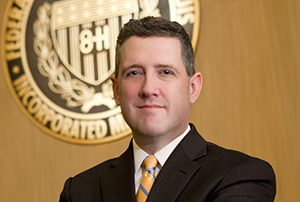Does Low Unemployment Signal a Meaningful Rise in Inflation?

James Bullard (Read his bio)
The text below, written by Federal Reserve Bank of St. Louis President James Bullard, appears as the President’s Message in the third quarter 2017 issue of The Regional Economist.
The unemployment rate in the U.S. is relatively low by recent historical standards. Some people argue that this means higher inflation is just around the corner, which they cite as a reason for the Fed to raise the U.S. policy rate (i.e., the federal funds rate target). In my view, however, low unemployment readings do not appear to be an indicator of substantially higher inflation to come.
Arguments that low unemployment will translate into high inflation are based on the so-called Phillips curve, which suggests that a negative relationship exists between the two variables. This relationship has been in the middle of central banking debates since the 1958 paper by the late economist A.W. Phillips. The Phillips curve dramatically fell out of fashion in the 1970s, when both high unemployment and high inflation gripped the U.S. economy and much of the rest of the world. In the inflation-targeting era that began in the 1990s, however, Phillips curve arguments have returned and have again been important in central banks’ decision-making.
But how robust is the relationship between unemployment and inflation in the data?1 In a recent analysis, economist Olivier Blanchard estimated a Phillips curve relationship for the U.S.2 The general finding was that the statistical relationship between unemployment and inflation is much flatter today than it has been historically.
Using Blanchard’s estimates for the U.S., we can see how much inflation would be generated if the unemployment rate continued to decline in the future. The table shows various predictions of what the inflation rate should be for a given unemployment rate, starting from the latest readings on unemployment and inflation (for July 2017 and June 2017, respectively). The results suggest that even if the unemployment rate declined substantially from its current level, the inflation rate would increase only modestly. For example, if unemployment fell from 4.3 percent to 3.5 percent, inflation would increase by only 0.16 percentage points. Furthermore, inflation would remain below 2 percent.
| Estimated Influence of Unemployment on Inflation | |
|---|---|
| If the unemployment rate was ... | The predicted core PCE inflation rate would be ... |
| 4.3%* | 1.50%* |
| 4.0% | 1.56% |
| 3.5% | 1.66% |
| 3.0% | 1.76% |
| 2.5% | 1.86% |
| SOURCES: Bureau of Labor Statistics, Bureau of Economic Analysis and author's calculations based on Blanchard (2016). | |
| * The first row contains the latest values for unemployment (July 2017) and inflation (June 2017). The inflation rate is measured as the year-over-year percentage change in the core personal consumption expenditures price index (core PCE). | |
| Federal Reserve Bank of St. Louis | |
There seems to be little risk—at least according to these estimates—that inflation would pick up appreciably from its current level solely because unemployment is low. The results shown here call into question the idea that unemployment outcomes are a major factor in driving inflation outcomes in the U.S. economy. Inflation expectations, for instance, are probably a more important determinant of inflation outcomes than unemployment.
Despite the empirical evidence suggesting that the Phillips curve relationship is relatively flat, some still argue in favor of raising the U.S. policy rate in an effort to get ahead of the anticipated surge in inflation. Implicit in that argument is the idea that the relationship is nonlinear, meaning the impact on inflation would be much larger once unemployment reached extremely low levels. However, I am not aware of empirical estimates that have made a convincing case for the nonlinear Phillips curve using recent data.
For monetary policy purposes, we should not base our notions of what will happen with inflation solely on ideas related to low unemployment. While we certainly want to keep an eye on inflation readings, there seems to be no strong case for being pre-emptive with respect to inflation simply because the unemployment rate is low.
Notes and References
1 For a FRED graph showing U.S. unemployment and core PCE inflation since 1995, see https://fred.stlouisfed.org/graph/?g=eBE3.
2 Blanchard, Olivier. “The US Phillips Curve: Back to the 60s?” Peterson Institute for International Economics, Policy Brief No. PB16-1, January 2016.
Additional Resources
- Regional Economist:
Does Low Unemployment Signal a Meaningful Rise in Inflation?
- From the President: A Low Inflation Surprise for U.S. Monetary Policy
- On the Economy: Has the Phillips Curve Relationship Broken Down?
Citation
ldquoDoes Low Unemployment Signal a Meaningful Rise in Inflation?,rdquo St. Louis Fed On the Economy, Aug. 29, 2017.
This blog offers commentary, analysis and data from our economists and experts. Views expressed are not necessarily those of the St. Louis Fed or Federal Reserve System.
Email Us
All other blog-related questions

